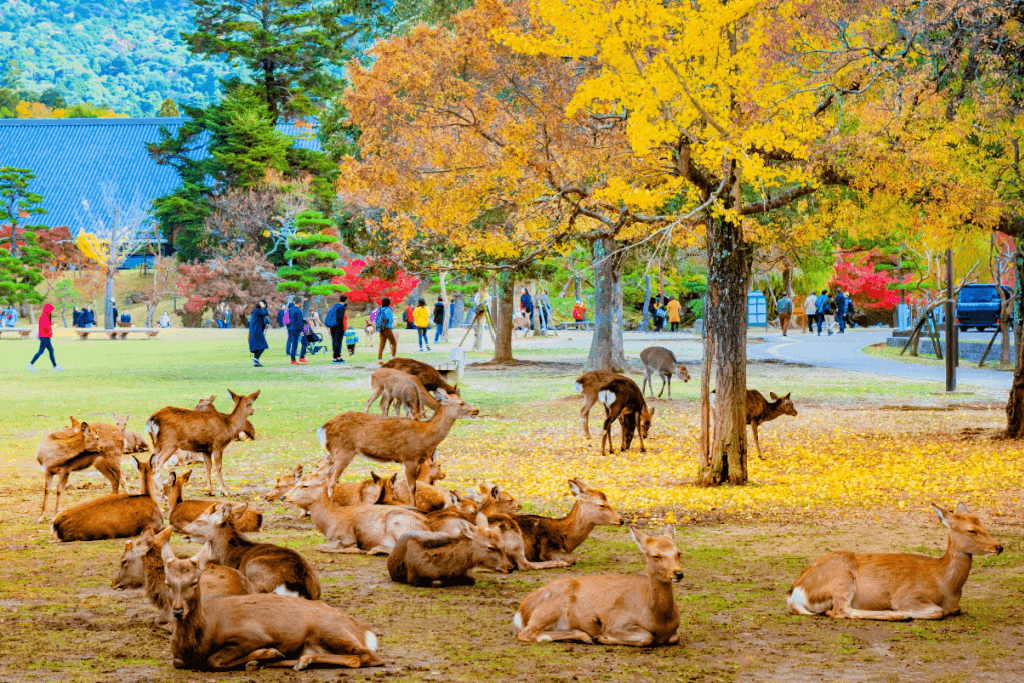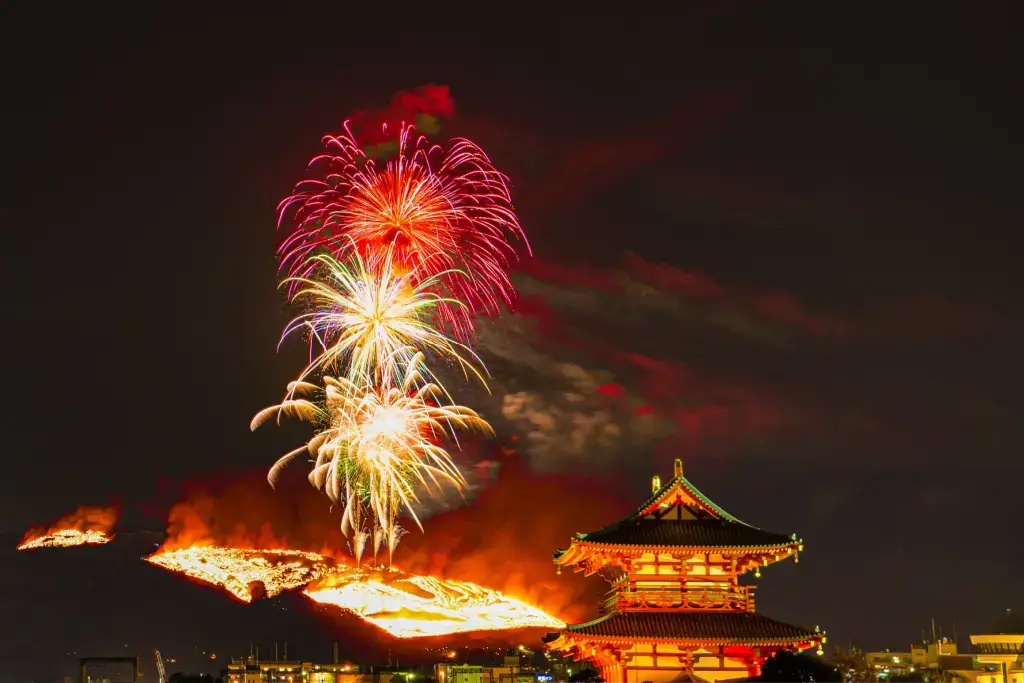Yamayaki (山焼き) is a centuries-old Japanese custom in Nara, Japan that involves ceremonially setting fire to mountainsides. Translated as “mountain burning,” the spectacular ceremony continues a tradition whose origins have been clouded by the passage of time.
Table of Contents
ToggleNara Japan
The Kansai region of Japan includes Hyogo, Kyoto, Shiga, Mie, Wakayama, and Nara prefectures. And Nara City, the capital of Nara prefecture, is a must when visiting the area. It is less than an hour from Osaka and perfect for day trips. Nara City boasts such national treasures as Horyuji Temple, the oldest wooden building in the world. It’s also home to Nara Park, one of the oldest parks in Japan.

The park is an expansive green space and historical area only 20 minutes walk from JR Nara station. Every year, over 10 million people visit the park to feed the wild shika deer and explore over five square kilometers of UNESCO World Heritage sites.
Japan has many capital cities. Historically, the country’s capital was located wherever the Emperor at the time resided. However, in 1868, the government relocated the capital from Kyoto to Tokyo. Before that time, Nara was the capital of Japan from 710 to 794. The now widespread yamayaki ritual originated here over 250 years ago.
Mount Wakakusa
Wakakusa yama(若草山) is a 350-meter hill located on the northern side of Nara Park and the location of the annual Nara yamayaki festival on the fourth Saturday in January. The park closes from December to March each year for the annual burning. However, during other times of the year, visitors can walk to the hilltop in less than an hour and enjoy scenic views of wild deer roaming among cherry blossoms, green grasses, or fall colors. After the festival day’s sunset, they raze the grass covering Wakakusa yama to provide visitors below with a spectacular nighttime scene accompanied by fireworks.
Nara Japan Yamayaki Origin
The reason for the first yamayaki is a mystery. The most widely accepted explanation points to a disagreement between the closest Buddhist temples, Todaiji and Kofukuji. The feud resulted in the purposeful or accidental burning of Mount Wakakusa. The ceremonial burning came to represent the resolution of the conflict.

Another theory points to the ancient burial site on the summit of Mount Wakakusa, known as Uguisuzuka Kofun. Legend has it that fearful travelers through the area started many fires because they believed the fire would prevent the spirits within from emerging. Todaiji and Kofukuji Temples were often at risk when these fires burned out of control. Allegedly, the temples began regularly setting fires as a preventative measure and to soothe travelers’ fears in the area.
Yamayaki Symbolism in Nara Japan
The modern meaning of the ritual could be a combination of both stories. In the Shinto religion, fire is suitable for cleansing and dispelling evil spirits. And every year, all temples in the area work together to manage the ceremonial burning process. They symbolically rid themselves of past differences and ward off evil spirits in the form of past mistakes.
The Nara Yamayaki Festival
The festival begins in the late afternoon, with Shinto priests dressed in white robes obtaining torches from the nearby Kasuga Taisha Shrine. Kasuga Taisha is home to Japan’s oldest torii (Shinto gate) and one of the many shrines near Wakusayama. More monks from other temples join in lighting the torches with scary fire at Mizuya Bridge.
There is a procession as the sacred flame is carried from shrine to shrine, led by the monks. The number of people and torches steadily grows as city officials and spectators join the sad procession. Attendees gather at the Nogami Shrine, located at the foot of Mount Wakakusa, to witness the lighting of a large bonfire. During the ritual, they pray for safety while the monks chant sutras.
Hundreds of Nara City firefighters carefully perform the controlled burn with the now sacred bonfire at selected burn points on the mountain. Nara City’s landscape includes World Heritage Sites and old, historical wooden buildings, making it susceptible to catastrophic loss from even a stray ember.
Consequently, authorities carefully monitor weather and winds for weeks leading up to the festival. After sunset, the burn is accompanied by a dramatic fireworks display that illuminates the night sky. Firefighters then extinguish the flames to ensure there are no surviving hot spots.
Are you looking to enjoy artisanal snacks from historical places like Nara, Japan? A taste of traditional Japanese snacks is all you need! Sakuraco sends traditional Japanese sweets, snacks, and tableware from across Japan to your door so that you can enjoy the experience!
Yamayaki in Other Locations
Though Nara’s yamayaki is the most well-known in Japan, similar fire rituals take place in various other locations across the country:
Gozan no Okuribi, Nara
In Japan, obon is one of the most important festivals of the year. It is held to honor ancestors and deceased relatives. Held in Kyoto on August 16th every year during obon, this festival competes with the Nara yamayaki for the title of Japan’s most famous fire festival.

It is sometimes called daimonji (“large character”) because of the prominent Japanese kanji characters formed on the mountainsides near the city. Bonfires are used to form the shapes of the kanji, one of which is the “large” or “大.” As with the Nara yamayaki, the origins of this custom are also still being determined. But, like Obon, it has its roots in ancient Japanese beliefs. The fires are believed to guide the spirits back to their place of rest after visiting their families here in the earthly realm.
Oto Matsuri Fire Festival, Wakayama
This yearly festival occurs in February and centers on the stone staircase leading up to Kamikurajinja shrine, a famous UNESCO World Heritage Site in Shingu City, Japan. Moreover, the tradition began long ago by the mountain priests of the area because farmers wanted to have a bountiful year.
Hundreds of men dressed in white to symbolize purity carry torches of sacred fire down the 538 stone stairs from the shrine while praying for good fortune. Though no hillsides are set ablaze, the image is of a river of fire flowing down the mountain toward onlookers at the base.

Overall, the yamayaki ritual strengthens communities via participation between various groups; It also supports local economies by attracting tourists worldwide. This is because regular fires control excess vegetation, thus preventing wildfires and protecting the many historical wooden structures nearby. In this way, the ritual ensures local history can be preserved far into the future. Are you thinking about visiting the Kansai region? Would you like to see any of the mountain-burning festivals? Let us know in the comments below!











